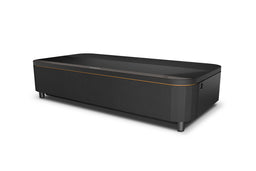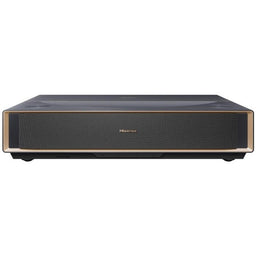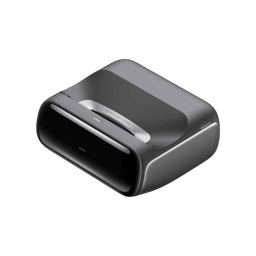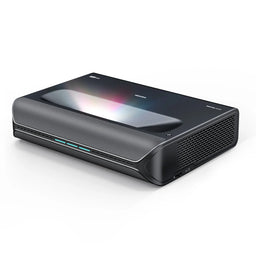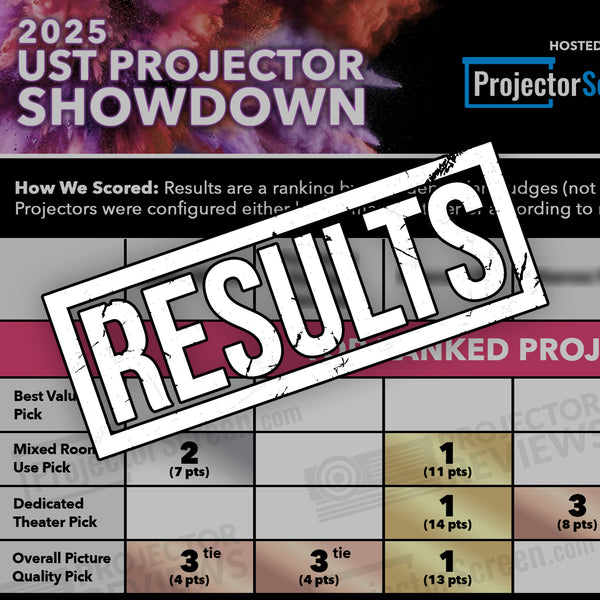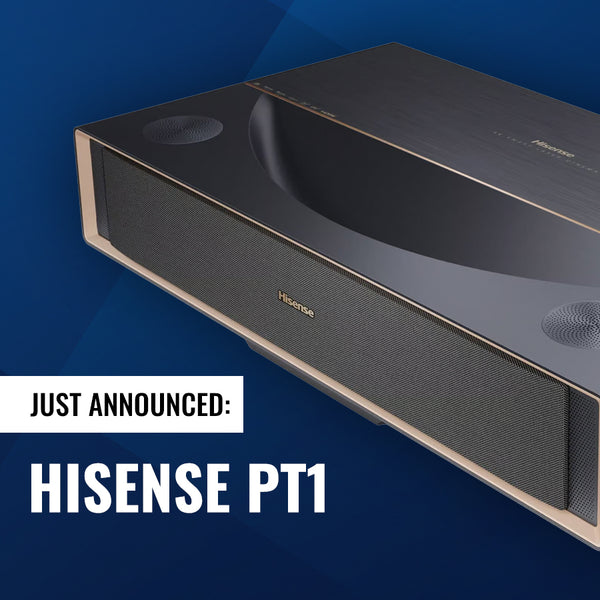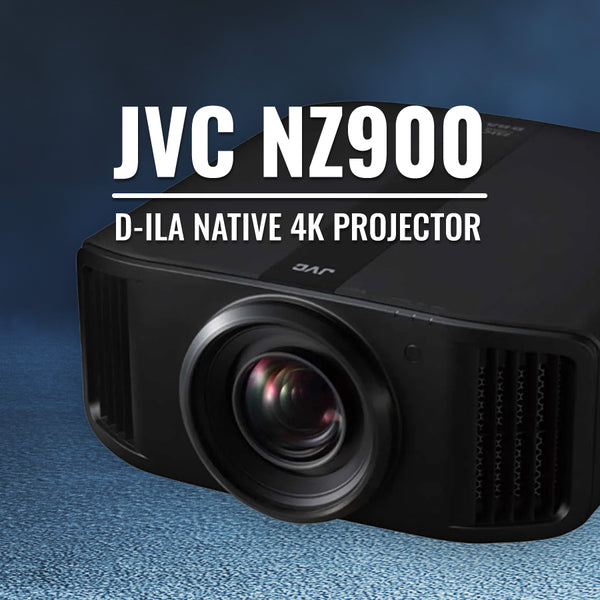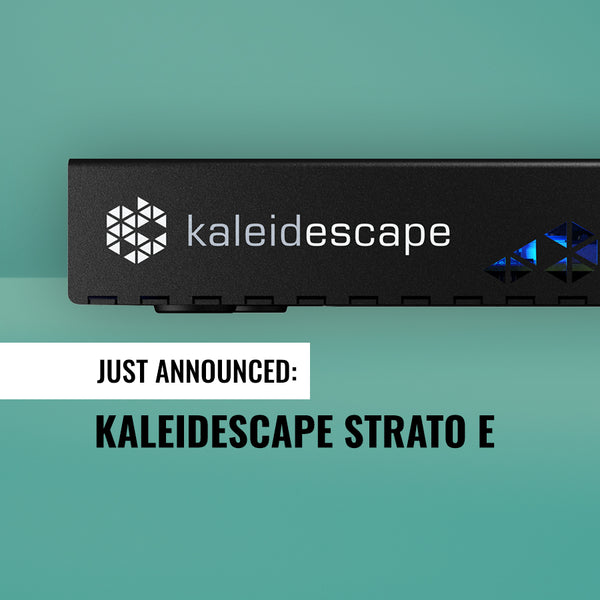
The 2025 UST Projector Showdown Results - Ultra Short Throw Projector Shootout

Our Fourth Annual Battle for the Best Ultra Short Throw Projectors
The wait is over - ProjectorScreen.com’s 4th Annual UST Projector Showdown is here! Over the past four years, our Showdown events have grown into the ultimate battleground for ultra short throw projectors. What started as a passion project in our New Jersey headquarters has become the industry’s most trusted, unbiased comparison, where every model faces the same rigorous, real-world testing.

At ProjectorScreen.com, we don’t just talk about performance: We show it. Our UST Showdowns, both on YouTube and right here on our site, are some of the most watched and requested events in the home theater world. Each one gives buyers the clearest, fairest look at how today’s top projectors really stack up.
This year’s event was once again directed by Phil Jones, Owner and Lead Reviewer at ProjectorReviews.com. Phil oversaw every aspect of the competition - from projector selection and judging criteria to the final scoring and judge coordination, ensuring a professional, independent, and transparent process.
While ProjectorScreen.com hosts and funds the event, no competing projector brands sponsor or influence the outcome in any way. We did receive gear support from trusted partners - Spectra Projection supplied all screens and UST carts, while Kaleidescape provided our reference-quality content source, but none of the participating manufacturers had any role in judging or results.
I want to emphasize that ProjectorReviews is running the show. Our team merely ran support during the event and were available to answer questions and assist Phil.
Every projector tested was pulled directly from our retail inventory - the exact same units our customers receive. No golden samples, no factory-tuned ringers, and no beta or pre-release firmware were used. Every model was tested in the same environment, under the same conditions.
In the weeks leading up to the Showdown, each manufacturer was invited to visit our Showdown Arena to personally configure and calibrate their projector, or to provide their recommended settings for our team to apply. Most took advantage of this opportunity but notably, Epson was the only company that declined to configure their unit or provide settings and opted instead to let Phil Jones determine the settings to use for the Showdown based on his extensive experience with their projectors.
Unfortunately a very popular and well reviewed projector, the Nexigo Aurora MKII’ score was pulled from the contest due to both a hardware and a firmware issue. At the 11th hour the night before the showdown, the MKII experienced an issue that caused the laser light engine to malfunction and become unstable. We had notified Nexigo immediately and told them that we would to go grab a fresh unit from the inventory that had just arrived to our warehouse the week before to get it updated and reconfigured with their designated settings. The unit updated the firmware directly to the current OTA version 1.3.8 and the settings were entered and we thought all was good.
That however, was not the case – we will get into detail about what occurred later in this write-up.
This only further emphasizes the fact that organizing an event of this scale is never easy, even in its fourth year, but we take on the challenge because every home theater fan wants to know:
Which ultra short throw projector in 2025 is the best for them?

Inside the 2025 UST Projector Showdown Evaluation Process
To determine the best ultra short throw projectors of 2025, ProjectorReviews.com put each contender through a rigorous, controlled, and repeatable testing process. The judges evaluated every unit across a variety of metrics designed to highlight real-world performance and overall image fidelity.
What We Tested
Each projector was stress-tested for:
- Color Accuracy and Dynamic Range in both SDR and HDR modes
- Resolution and Detail in still images and motion sequences
- Image Scaling, Processing, and Motion Handling
- Contrast and Shadow Detail in both bright and dark room scenarios
Additionally other considerations were taken into account such as install flexibility, and optical artifacts to name a few.
All of these projectors were initially configured either directly by the manufacturer onsite or by using settings they provided covering picture mode, motion processing, dynamic contrast, and more. Each unit was then professionally white-balanced to D65 using Colorimetry Research instruments. However, even when two displays measure the same D65 on calibrated equipment, they can still look different to the human eye due to display metamerism - the way different light spectra can produce slightly different visual impressions. To minimize this, ISF Level III calibrator Cecil Meade performed a final visual pass to ensure the white balance appeared uniform across all projectors. This approach ensured that measurement accuracy and perceptual matching were both achieved, giving us the most fair, apples-to-apples comparison possible.
The Setup
Every projector was paired with an identical 100-inch Spectra Projection Vantage ambient-light-rejecting screen, one of the top-performing UST ALR screens available today. This provided a consistent, neutral foundation that allowed the projectors’ true performance to shine through.
We chose this screen for several reasons:
- It has consistently been praised as the best performing UST material at the price point.
- It is lenticular, which is the most widely used UST screen technology due to its wide viewing angle and ability to be made in larger sizes and is both available in fixed-frame and motorized options.
- The way that it redirects light to the viewer from the steep angle below it and how it rejects light from other directions helped to mitigate the ambient light coming from the other projectors in the room.
- While UST projectors are capable of producing much larger image sizes than the 100” that we used, we were limited by space and time for this Showdown as we just moved into our new HQ a couple of months ago and only had the single 1200 square foot Showroom space completed. We do plan on using larger screens next year to demonstrate the magnitude of the image that these projectors are capable of producing.

All eight projectors were evaluated side by side using a consistent set of test patterns and real-world movie and TV scenes, played back exclusively from a Kaleidescape media server. We used Kaleidescape again this year because it let us create an efficient and repeatable testing workflow; its scene and playlist tools made it easy to cue identical clips across every test round, and its locally stored, high-bitrate files ensured stable playback without the inconsistencies that can come from discs or streaming.
This gave us a clean, uncompromised video signal for each projector and allowed the judges to focus on image performance, not source variability.
The synchronized video feed was distributed to all eight units through professional-grade distribution amplifiers and equal length fiber hdmi cables, regardless of their position to the sources.
A calibrated 55" Samsung S90F QD-OLED TV was used as a consistent reference display throughout the event, giving judges a stable benchmark for color accuracy, detail, and overall image integrity.

The Viewing Environment
To replicate real-world living room conditions while maintaining consistency, we used custom non-reflective divider panels to prevent light bleed between screens. The Showdown Arena was equipped with both cool and warm dimmable lighting, allowing us to simulate a range of viewing environments, from dark room conditions to moderately lit and very bright settings. This gave judges the ability to evaluate each projector’s performance under realistic scenarios without introducing harsh or uneven overhead glare, when not wanted but also to flood the room with a higher level of light than one would expect in any living environment.
Each projector was configured and evaluated in both SDR and HDR modes, tested under lights-on and lights-off conditions. No beta firmware, golden samples, or pre-production units were permitted - only retail units running publicly available firmware were used.
The Scoring System
Judges completed detailed ballot sheets rating each projector on key image-quality attributes, including:
- Color Accuracy
- Contrast
- Black Level / Shadow Detail
- Detail / Sharpness
- Installation Flexibility: Which includes things such as aesthetics, features, image correction, wall color correction, image flattening, placement options and more.
Various pieces of content were used to challenge both the SDR and HDR handling of each of the projectors; below are some examples of the clips used and the tests they applied to:
Motion Handling
- Baby Driver — Opening / Harlem Shuffle (6:30)
Color Reproduction
- Samsara — Sand Art (10:14)
- The Great Wall — Gold Room (1:07:18)
- The Great Wall — Tower Shot (1:23:51)
Black Levels & Shadow Detail
- The Batman — TV Before Bedtime (2:12)
- Nope — First Sighting (48:58)
- Harry Potter and the Deathly Hallows: Part 2 — Death Eaters Attack Hogwarts (54:45)
HDR Performance & Tone Mapping
- Aquaman — Throne Room (50:24)
- The Meg — Landing on Mana One (4:54)
- The Meg — The Meg’s Revenge (49:26)
Scores were tabulated in two distinct ways:
- Point Score – Points from each criterion were tallied and averaged with the scorecard reflecting the highest value of all projectors for that specific category.
- Overall Judges’ Picks – Each judge also selected their top three favorites overall in the following 4 categories awarding 3 points for their #1 choice, 2 points for #2, and 1 point for #3. These ranked-choice votes determined the final “Judges’ Choice” standings.
- Best Value Pick
- Mixed Room Use Pick
- Dedicated Theater Pick
- Overall Picture Quality (PQ) Pick
In most cases, the total-point rankings aligned closely with the judges’ top-three selections, but not always. Some projectors scored higher in raw metrics yet fell behind in overall preference due to factors like perceived image balance, usability, or performance across mixed content.
After the lunch break, all projectors were factory-reset to remove any prior adjustments and evaluate them strictly in their out-of-the-box configurations.
Interestingly, in some instances judges even preferred the default projector image over the manufacturer-recommended settings, which underscores how subjective image quality can be. This variability is exactly why having multiple judges is so important: different viewers respond differently to color tone, sharpness, contrast, and motion handling. Small differences in factory presets or processing options can influence what looks “best” to each person. By combining technical calibration, a high-quality reference display, and a diverse judging panel, the results reflect a fair and well-rounded evaluation of each projector’s true performance.
The Judges
Let's meet the judges:
We have Andy Grimm joining us again for his 3rd year at the Showdown. Andy is a projector reviewer and contributor for Home Theater Review, Sound and Vision as well as his own website Pixel Home Theater. He is also a display calibrator and a very prolific contributor to the AVS Forum and a Pixel Pusher in the truest sense of the words.
We also have another repeat-offender judge, Chris Majestic. Chris has been a part of every UST Showdown since it’s inception and his insight and experience is a tremendous asset to this event. Chris is a very experienced technology and projector reviewer with a wildly popular youtube channel @ChrisMajestic, who also uses a UST projector as his primary display in his personal living room.

Kam Valentine - an ISF certified calibrator and reviewer for ProjectorReviews.com joins us for his 2nd year and brings a great breadth of projector experience and a critical eye from a more technical frame of reference.
Chris Boylan also joins us again this year as one of our esteemed judges. Chris is an ISF trained calibrator and Technology journalist who has been reviewing and writing about audio and video technology since 1993. Chris founded the tech site Big Picture Big Sound in 2005 and is currently the editor at large for the popular av technology website Ecoustics.
We also are fortunate to have Milton Santiago AKA EBPMAN join us again this year; his 2nd as a judge in the Showdown. Through his popular Youtube channel EBPMAN Tech Reviews, Milton has reviewed many projectors and also enjoys the big screen experience that UST projection affords in his own home.

Our last judge, Chris Mata joins us in the arena for the first time this year. Chris is a level 3 ISF certified calibrator has been in the Home Theater industry for many years doing custom design, integration and more. His Youtube channel persona, That Home Theater Dude reviews products in a frank, no-bs manner without pulling any punches.

The Ultimate UST Battle
This year, eight ultra short throw laser projectors entered the arena for the most comprehensive and competitive head-to-head test in Showdown history, but only 7 made it out alive.
So, what did the judges think? How did these projectors perform when pushed to their limits?
Let’s take a look at the Scorecard.



The Results Are In
Scroll down to see the rankings, scores, and results to see how each of these UST Projectors did in 2025.
The Contestants in alphabetical order:
Epson QS100


Earning a 2nd place pick from our judges for Mixed Room Use and tying in 3rd for Overall Picture Quality, this 4500 lumen projector’s brightness and lack of rainbow effect and laser speckle proved to be it’s primary strengths. Being the only LCD projector in the mix, it did have an inherent disadvantage regarding optical artifacts and sharpness and being the only single laser it did have the most narrow color gamut but still earned the respect of the judges.
SDR MODE
HDR MODE
GENERAL PERFORMANCE
OUT OF THE BOX
As of November 17, 2025

Software On Unit: |
Epson QS100B Settings Used on November 8th |
|
|---|---|---|
Content Type: |
HDR |
SDR |
Picture Mode |
Cinema |
Natural |
Brightness |
50 |
50 |
Contrast |
50 |
49 |
Color Saturation |
50 |
50 |
Tint |
50 |
50 |
Sharpness |
5 |
5 |
White Balance - Color Temp |
9 |
6500K |
White Balance - GM Correction |
2 |
4 |
Frame Interpolation |
Off |
Off |
Dynamic Contrast |
High |
Normal |
Image Enhancement |
On (Preset 2) |
On (Preset 1) |
Noise Reduction |
4 |
2 |
MPEG Noise Reduction |
Normal |
Low |
Super Resolution |
4 |
1 |
Auto Contrast Enhancement |
4 |
2 |
Dynamic Tone Mapping |
On |
N/A |
Scene Adaptive Gamma |
2 |
0 |
Gamma |
-1 |
0 |
RGB CMY Settings |
All settings 50 (Default Settings) |
All settings 50 (Default Settings) |
Color Space |
Auto |
Auto |
Dynamic Range |
Auto |
Auto |
*Brightness cd/m² (nit) on a 0.5 gain screen |
144.6 |
145.8 |
*Black Luminance(Floor) cd/m² (nit) on a 0.5 gain screen |
0.055 |
0.057 |
*Contrast Ratio |
2,629:1 |
2,551:1 |
Firmware Version |
WWV100 |
|

Hisense L9Q



This projector took top mark in 3 of the Judge’s picks categories; Mixed Room Use, Overall Picture Quality and somewhat surprisingly, Dedicated Theater Room. It also had top score in many of the categories in which the USTs were compared against the OLED. Where it certainly did not win over the Judge’s was it’s perceived Value, not getting a single Judge’s pick against the less expensive options in the group. While it may not have been perceived as 2x better than the PX3-Pro which sells for half the cost, the L9Q clearly won over all of the judges as the top performer overall.
SDR MODE
HDR MODE
GENERAL PERFORMANCE
OUT OF THE BOX
As of November 17, 2025

Hisense L9Q Settings Used on November 8th (Configured by Hisense) |
||
|---|---|---|
Content Type: |
HDR |
SDR |
Picture Mode |
HDR Cinema |
Cinema |
Content Type Auto Detection |
Off |
Off |
Scenario Enhancement/High Dynamic |
High |
High |
Dark Detail |
On |
Off |
Active Contrast |
Low |
Low |
Dynamic Tone Mapping |
On |
N/A |
HDMI Dynamic Range |
Limited |
Limited |
Color Temp |
Warm 2 |
Warm 2 |
Motion Enhancement |
Clear |
Clear |
2 Point - R Gain |
0 |
0 |
2 Point - G Gain |
0 |
0 |
2 Point - B Gain |
0 |
-10 |
Color Tuner Blue |
(No Change) |
Hue: -3 |
*Brightness cd/m² (nit) on a 0.5 gain screen |
154.8 |
142.1 |
*Black Luminance(Floor) cd/m² (nit) on a 0.5 gain screen |
0.076 |
0.034 |
*Contrast Ratio |
2,044:1 |
4,131:1 |
Firmware Version |
V03.01.00Q.P1103 |
|

Hisense PT1

SDR MODE
HDR MODE
GENERAL PERFORMANCE
OUT OF THE BOX
As of November 17, 2025

Hisense PT1 Settings Used on November 8th (Provided by Hisense) |
||
|---|---|---|
Content Type: |
HDR |
SDR |
Picture Mode |
HDR Theater |
Theater |
Content Type Auto Detection |
Off |
Off |
Scenario Enhancement/High Dynamic |
High Dynamic |
High Dynamic |
Dark Detail |
On |
Off |
Active Contrast |
Low |
Off |
Dynamic Tone Mapping |
On |
N/A |
HDMI Dynamic Range |
Limited |
Limited |
Color Temp |
Warm 2 |
Warm 2 |
Motion Enhancement |
Clear |
Clear |
2 Point - R Gain |
0 |
1 |
2 Point - G Gain |
-5 |
-5 |
2 Point - B Gain |
0 |
0 |
Color Tuner Blue |
(No Change) |
(No Change) |
*Brightness cd/m² (nit) on a 0.5 gain screen |
63.4 |
63.2 |
*Black Luminance(Floor) cd/m² (nit) on a 0.5 gain screen |
0.026 |
0.03 |
*Contrast Ratio |
2,455:1 |
2,109:1 |
Firmware Version |
V0000.01.00D.P0612 |
|

Hisense PX3-Pro




The PX3-Pro blends both high brightness with high contrast and peppers in a mix of high sharpness, strong tone mapping, great color accuracy and other attributes that let this unit take away the most accolades of the group this year.
SDR MODE
HDR MODE
GENERAL PERFORMANCE
OUT OF THE BOX
As of November 17, 2025

Hisense PX3-Pro Settings Used on November 8th (Configured by Hisense) |
||
|---|---|---|
Content Type: |
HDR |
SDR |
Picture Mode |
HDR Theater |
Theater |
Content Type Auto Detection |
Off |
Off |
Scenario Enhancement/High Dynamic |
On |
On |
Dark Detail |
On |
Off |
Active Contrast |
Low |
Off |
Dynamic Tone Mapping |
On |
N/A |
HDMI Dynamic Range |
Limited |
Limited |
Color Temp |
Warm 2 |
Warm 2 |
Motion Enhancement |
Clear |
Clear |
2 Point - R Gain |
0 |
0 |
2 Point - G Gain |
0 |
0 |
2 Point - B Gain |
0 |
0 |
Color Tuner Blue |
(No Change) |
(No Change) |
*Brightness cd/m² (nit) on a 0.5 gain screen |
110 |
108.7 |
*Black Luminance(Floor) cd/m² (nit) on a 0.5 gain screen |
0.035 |
0.036 |
*Contrast Ratio |
3,169:1 |
3,001:1 |
Firmware Version |
V0000.01.00S.01122 |
|

JMGO O2S Ultra
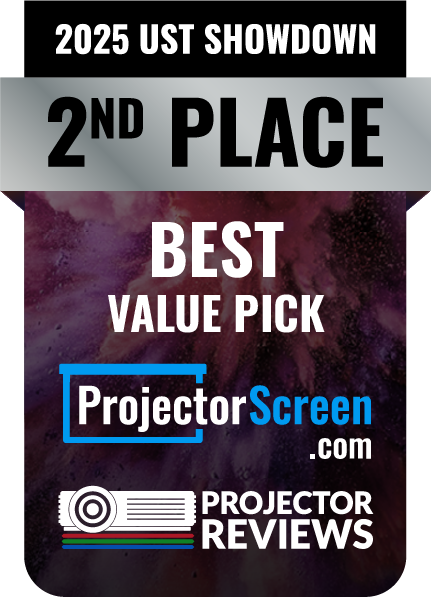
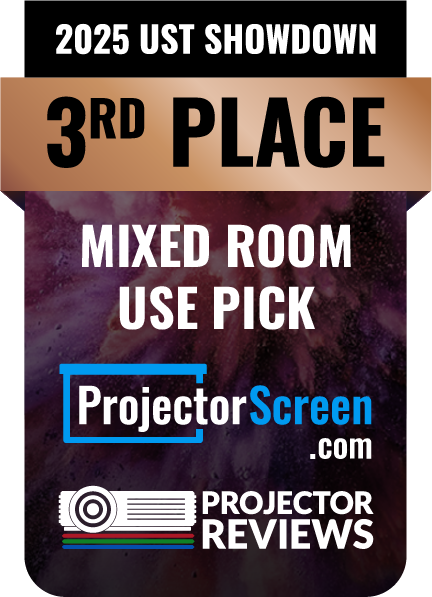
While there were no doubt issues with the firmware, limiting calibration controls and causing some less than optimal behaviors there is no doubt that this projector will only get better with time as JMGO continues to refine and update the software and iron out some bugs.
Where this projector earned a lot of praise and a whoppingly high score was in the Installation Flexibility category. It’s small, unique form factor made it extremely portable and its image flattening, geometric correction, small throw distance and other features made this unit a hot topic of conversation between the judges.
This would no doubt be a projector I would suggest to someone who wanted something easy to take on the go and blast up against any wall, without a screen and still get a bright, vibrant image that will no doubt keep getting better with future updates.
SDR MODE
HDR MODE
GENERAL PERFORMANCE
OUT OF THE BOX
As of November 17, 2025

JMGO O2S Ultra Used on November 8th |
||
|---|---|---|
Content Type: |
HDR |
SDR |
Picture Mode |
Movie |
CineTuner |
Projector Light Output |
10 |
10 |
Adaptive Brightness |
Off |
Off |
Brightness |
50 |
50 |
Contrast |
0 |
10 |
Saturation |
50 |
50 |
Hue |
0 |
10 |
Sharpness |
0 |
10 |
Color Temp |
Warm |
Cool |
Red Gain |
0 |
0 |
Green Gain |
-3 |
-1 |
Blue Gain |
-41 |
-1 |
Gamma |
Midde |
Midde |
HDMI RGB Range |
Auto |
Auto |
Color Space |
N/A |
DCI |
DNR |
Off |
Medium |
MPEG Noise Reduction |
Off |
Off |
Adaptive Luma Control |
Off |
Medium |
Local Contrast |
Off |
Medium |
Dynamic Color Boost |
Off |
Off |
AISR |
Off |
Off |
Decontour |
Middle |
Middle |
HDR |
On |
N/A |
MEMC |
Off |
Off |
*Brightness cd/m² (nit) on a 0.5 gain screen |
112.7 |
117.9 |
*Black Luminance(Floor) cd/m² (nit) on a 0.5 gain screen |
0.051 |
0.054 |
*Contrast Ratio |
2,196:1 |
2,173:1 |
Firmware Version |
1.1.31.13 |
|

XGIMI Aura 2 GTV

That being said, its performance to price ratio was quite strong as the least expensive projector in this mix, earning it a 3rd place pick for Best Value from our Judges. An all-around good performer, with great features and at an even better price with what many said has the best aesthetics and “wife acceptance factor” in the room with nowhere to go but up as XGIMI continues to update the firmware, correct some bugs and enhance the image quality and calibration controls.
SDR MODE
HDR MODE
GENERAL PERFORMANCE
OUT OF THE BOX
As of November 17, 2025

XGIMI Aura 2 GTV Used on November 8th |
||
|---|---|---|
Content Type: |
HDR |
SDR |
Picture Mode |
Movie |
Standard |
Projector Light Output |
10 |
10 |
Optical Color Filter |
On |
Off |
Brightness |
50 |
50 |
Contrast |
50 |
50 |
Saturation |
50 |
50 |
Sharpness |
6 |
10 |
11 - Point White Balance |
Not Enabled |
Enabled (All Values 50) |
2 - Point White Balance |
All Values 50 |
Red 50, Green 50, Blue 42 |
Offset |
All Values 50 |
All Values 50 |
Color Temp |
D65 |
Color Temp 1 |
Gamma |
Middle |
Dark |
Color Space |
Not Adjustable |
Native |
Color Tuner |
All Values 50 |
Saturation Red 39 |
MEMC |
Off |
Off |
HDR |
On |
Medium |
DNR |
Off |
Low |
MPEG Noise Reduction |
Off |
Low |
AI PQ |
Off |
Off |
DI Fill Mode |
Off |
Off |
Adaptive Luma Control |
Off |
Medium |
Local Contrast Control |
Off |
Low |
Decontour |
Middle |
Off |
Low Blue Light |
Off |
Off |
*Brightness cd/m² (nit) on a 0.5 gain screen |
90.1 |
90.1 |
*Black Luminance(Floor) cd/m² (nit) on a 0.5 gain screen |
0.046 |
0.046 |
*Contrast Ratio |
1,960:1 |
1,960:1 |
Firmware Version |
V1.0.48 |
|

NexiGo Aurora Pro MK2
I cannot say exactly where the Nexigo Aurora Pro MKII would have ended up on the scorecard, but I have no doubt that it would have received higher scores across many of the judging criterion and could very well have placed in the top three Judges Picks for several categories, most specifically the Dedicated Theater Room Pick.
For what it’s worth, I personally recommend it to anyone seeking exceptional black levels, shadow detail, and dark-room performance in a UST.
We will be doing an in-depth review of this unit on our blog and will be getting units into the hands of several of the Judges to do their own reviews on their respective platforms as well.
As of November 17, 2025

Nexigo Aurora Pro Mark II Settings Used on November 8th (Provided by Nexigo) |
||
|---|---|---|
Content Type: |
HDR |
SDR |
Picture Mode |
Cinema Pro |
Cinema Pro |
Iris Setting |
Lite |
Lite |
SAE Setting |
Mid |
Mid |
EOTF |
No Change |
High |
Dynamic Contrast |
No Change |
Low |
MEMC |
Low |
Low |
Advanced Color Management |
No Change |
Yellow Hue - 31 |
Color Temp |
Warm 2 |
Warm 1 (49, 48, 44) |
Contrast |
55 |
No Change |
Saturation |
50 |
No Change |
24p Mode |
Auto |
Auto |
Dynamic Tone Mapping |
On |
N/A |
*Brightness cd/m² (nit) on a 0.5 gain screen |
71 |
74.6 |
*Black Luminance(Floor) cd/m² (nit) on a 0.5 gain screen |
0.029 |
0.032 |
*Contrast Ratio |
2,448:1 |
2,305:1 |
Firmware Version |
1.3.8 |
|

Measurements

HDR SETTINGS SDR SETTINGS |
Epson QS100B |
Formovie Theater Premium |
Hisense L9q |
Hisense PT1 |
Hisense PX3-Pro |
JMGO O2S Ultra |
XGIMI Aura 2 GTV |
Nexigo Aurora Pro MKII |
|---|---|---|---|---|---|---|---|---|
Brightness HDR cd/m² (nit) on a 0.5 gain screen |
144.6 |
87.2 |
154.8 |
63.4 |
110 |
112.7 |
90.1 |
71 |
Black Luminance(Floor) HDR cd/m² (nit) on a 0.5 gain screen |
0.055 |
0.027 |
0.076 |
0.026 |
0.035 |
0.051 |
0.046 |
0.029 |
Contrast HDR |
2,629:1 |
3,288:1 |
2,044:1 |
2,455:1 |
3,169:1 |
2,196:1 |
1,960:1 |
2,448:1 |
Brightness SDR cd/m² (nit) on a 0.5 gain screen |
145.8 |
100.2 |
142.1 |
63.2 |
108.7 |
117.9 |
90.1 |
74.6 |
Black Luminance(Floor) SDR cd/m² (nit) on a 0.5 gain screen |
0.057 |
0.03 |
0.034 |
0.03 |
0.036 |
0.054 |
0.046 |
0.032 |
Contrast SDR |
2,551:1 |
3,371:1 |
4,131:1 |
2,109:1 |
3,001:1 |
2,173:1 |
1,960:1 |
2,305:1 |

Takeaways
The comments that I heard from many of the judges is that this year was the hardest year to judge to date as all of the projectors involved were really good, all with their own sets of strengths and weaknesses, but not being bad.
I think one of the biggest takeaways for this year’s UST Showdown is that in the eyes of the judges, that brightness was best, even in a dark room. Granted the showdown arena is not a totally blacked out bat-cave enabling the black floor to be as truly low as it could be due to the ambient light created by the other projectors, despite all of the efforts put forth into isolating each projector from the other projectors light. It was a sacrifice that had to be made in order to allow for all units to be on at the same time, in the same room to leave nothing to the memory of the judges and allow them to compare in real time against each other.
Even with nominal levels of ambient light introduced by the other projectors, the judges were still very easily able to see the differences in black floor, shadow detail and contrast between the units. Based on how they awarded their picks, one could derive from the data that they favored the overall image of the brighter projectors, with the wider color gamut, sharper image and superior tone mapping to those that’s major strengths were attributed to solely their dark room performance.
While I strive to help make these events as informative as possible to prospective consumers of UST Projectors, there is no way to empirically state that one projector is necessarily “the best” for every person or every environment. Certain features, capabilities and functionalities may be more important to one person than another.
It’s important to note that some judges favored projectors with higher brightness and slightly elevated black floors over dimmer models with deeper blacks. In many cases, the brighter units delivered greater perceived contrast, image depth, and punch - qualities that held up not only in mixed or bright-room environments, but also in the judges’ own dedicated theater spaces, where overall image impact mattered as much as absolute black level.
While projectors with lower black levels may technically excel in absolute darkness, the judges prioritized overall picture quality and real-world versatility, rewarding models that maintained impactful images across a broader range of viewing environments.
I also want to stress that projection is not just a 1 piece system; in order to get the optimal experience one must take into account not only the projector but also the screen size, screen material, seating position and ambient lighting.
A UST projector that may be ideal in a bright room on a smaller screen may not work so well in the same room on a larger screen, with a different screen material or in a darker room on a larger screen as was evident when we started playing with some of these items on a larger 150” UST screen from Spectra Projection or making even larger images directly on the 14’ tall wall. The size of your desired image will directly impact the amount of brightness that you will need and will also affect the black floor and perceived contrast.
As an example, a unit such as the L9Q which would have an inferior black floor reading compared to the PT1 on a 100” screen with have a much lower black floor when the image size increases 225% to a 150” where the PT1 would still have a lower black floor but perhaps not enough brightness for ones preference at such a large image size.
Ensuring that you take all of these factors into consideration can be intimidating and confusing, even with all of the great information and opinions that you can get from this year’s and past Showdown events.
Fortunately, we are here to help. Our team of specialists not only has extensive experience with all of these showdown projectors; we understand the importance of how all of these factors interplay so that we can help you determine what is the best setup for your specific needs, environment and budget. We don’t just know UST projectors either, we are one of the largest specialty retailers for projection and home theater equipment with agents standing by to answer any of your questions and help you design the big screen experience of your dreams.
I also want to stress the importance of how it is not just the hardware in these units that is what makes them so great (or not) but also the software. Some of these projectors have been around for a while and have had many updates to their firmware to address bugs, add features and enhance image quality. Most notably would likely be the L9Q.
While still a newer projector, it has had several updates to it’s firmware to enhance image quality and while the native contrast ratio was no improved; the curve that Hisense had adjusted has had a significant improvement on the perceived contrast and overall picture quality.

The topic we can’t ignore
This brings us to the obvious question about what happened with the Nexigo Aurora Pro MKII. I have genuinely lost sleep over this. We have been running this projector in our showroom for several months and have been consistently impressed with its performance. I fully expected it to do well in the Showdown. The amount of interest around this model is completely justified. Nexigo’s use of a dynamic iris combined with laser dimming has made it a standout for dark room performance and it has received strong reviews from respected sources. Many people on the forums assumed it would be a leading contender this year, and I also believed it would rank highly in at least the Dedicated Theater category, if not more.
On Friday night, the evening before the Showdown, at around 6:30 pm, our unit suddenly began showing severe strobe-like flickering, almost as if the laser light source was rapidly shutting on and off. We contacted Nexigo right away to let them know, and we pulled a fresh unit from the newly arrived shipment to replace it. Within an hour we had the new unit unpacked, updated to the latest OTA firmware, entered the settings Nexigo provided, ran a quick test, and everything appeared normal. We closed up for the night feeling confident that the replacement was ready for the event.
During the Showdown, a few people who were familiar with the Nexigo commented that something seemed off compared to what they had previously seen, but we assumed it might be related to the settings Nexigo had chosen for the competition. After the lunch break, all projectors were factory reset for the Out of the Box judging. Right after the reset, the Nexigo actually seemed to improve and the judges noticed it as well.
It was not until the next day, when Phil and I were reviewing the score sheets, that the issue became impossible to ignore. Not a single judge selected the Nexigo in any category, and its overall scores were surprisingly low, even in the HDR dark room tests where we expected it to shine.
We powered it back up in the Showdown Arena to compare it again with the other units. Once everything was put back into the pre-reset “Showdown mode,” the image looked far better than what the judges had seen. It was immediately clear that something had gone wrong during the event.
We spent more time investigating, speaking with judges, colleagues, and Nexigo to figure out what had happened. We eventually discovered that the newly shipped units had been running the original factory firmware. When updated directly from that early firmware to the current OTA version 1.3.8, certain features appeared in the menus and were able to be configured, but did not actually operate correctly. Settings such as iris lite mode, SAE, dynamic tone mapping, and gamma controls were visible, but selecting them did not always apply the intended behavior.
Nexigo suggests that a Factory Reset be performed when making this large jump in firmware versions, however there was no prompt with this latest firmware that a factory reset would be needed, nor did Nexigo inform us of that when we let them know of the original unit failure.
Unfortunately, with a live event involving multiple judges, staff, and scheduled production, it simply was not possible to redo the event. I want to be very clear that this should not be taken as a sign that Nexigo products lack quality or reliability. What happened is not consistent with what we have experienced in our own showroom or with our customers nor the general consensus online. It was an unfortunate situation that just happened to occur at the worst possible time, under the spotlight.
I cannot say exactly where the Nexigo Aurora Pro MKII would have ended up on the scorecard, but I have no doubt that it would have received higher scores across many of the judging criterion and could very well have placed in the top three Judges Picks for several categories, most specifically the Dedicated Theater Room Pick
For what it’s worth, I personally recommend it to anyone seeking exceptional black levels, shadow detail, and dark-room performance in a UST.
We will be doing an in-depth review of this unit on our blog and will be getting units into the hands of several of the Judges to do their own reviews on their respective platforms as well.
We will be including photos of the Nexigo showing how it looked once functioning correctly, as well as measurements so that you can compare them with the other projectors and form your own conclusions.
Sponsors
Our primary sponsor, Spectra Projection came through again this year for us and provided 8 of the best ultra short throw projector screens to use for this competition, which ensured all projectors were using an identical & uniform 4K rated surface that was ideal for the type of competition we held. They also provided us with specialized carts for UST projectors with mounting carts made for USTs.
Kaleidescape again was the official media source for the Showdown and their expansive catalog and impeccable fidelity provided a flawless viewing experience.
Conclusion
You’d think that after hosting this event for four years, we’d have it down to a science. The truth is that it never gets easier.
Bringing together the best ultra short throw projectors in the country for a true side-by-side comparison is an enormous undertaking. From coordinating logistics and calibration to judging and analysis, every step requires precision, teamwork, and an unwavering commitment to fairness. Our six expert judges, dedicated event staff, and Showrunner Phil Jones all delivered an incredible effort once again, providing an invaluable service to projection enthusiasts everywhere.
This year’s Showdown wasn’t just about competition - it was about community. Seeing familiar faces from past years and welcoming a new judge to the fold created a perfect blend of camaraderie and expertise. Listening to their passionate discussions, debates, and good-natured banter throughout the event reminded us why this event matters so much: everyone here truly is passionate about projection.
One of the enduring lessons of the UST Showdown is how dramatically your perception of a projector can shift when you see it directly next to others. Reviewing a unit in isolation tells only part of the story, but when every model shares the same screen size, lighting, and content, the differences become crystal clear. That’s the magic of this event.
You might find walls of TVs lined up in a retail showroom, but when it comes to ultra short throw projectors, no other place in the world assembles a collection like this. Our Showdown Arena at ProjectorScreen.com remains the only environment where such a large number of USTs can be evaluated side by side under various conditions.
Be sure to bookmark our Showdown write-up page and check back soon! We’ll be adding even more content, analysis, measurements, photos and behind-the-scenes insights that didn’t make the initial release. We wanted to get the results out to you as quickly as possible, but there’s plenty more to share.
Thank you for joining us for the 4th Annual UST Projector Showdown, where we put the top ultra short throw projectors of 2025 to the test so you can confidently choose what’s right for you.
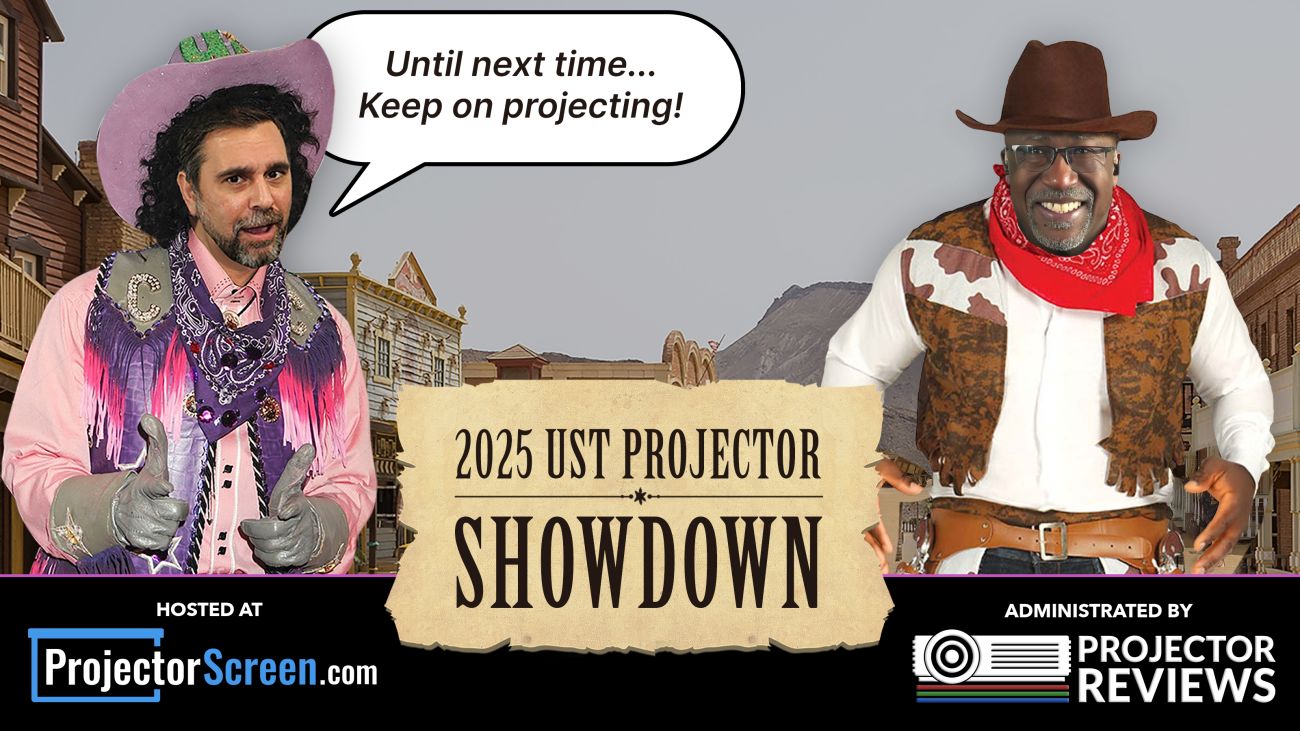
- Choosing a selection results in a full page refresh.
- Opens in a new window.








